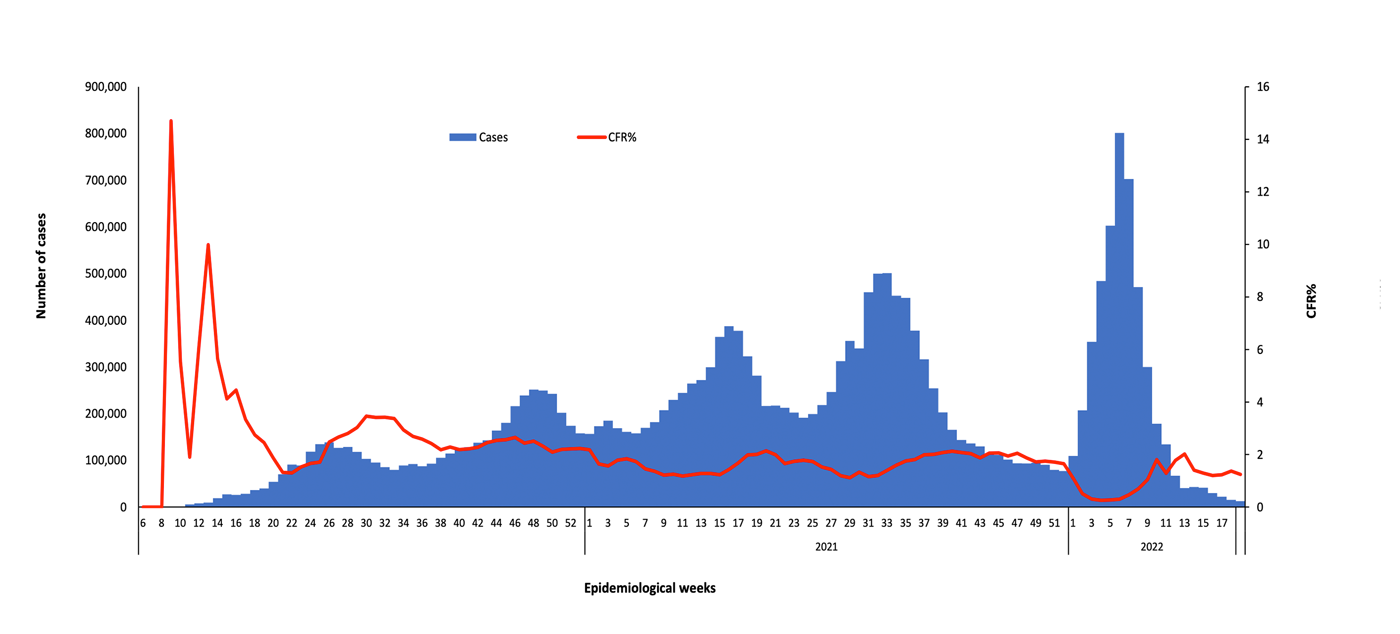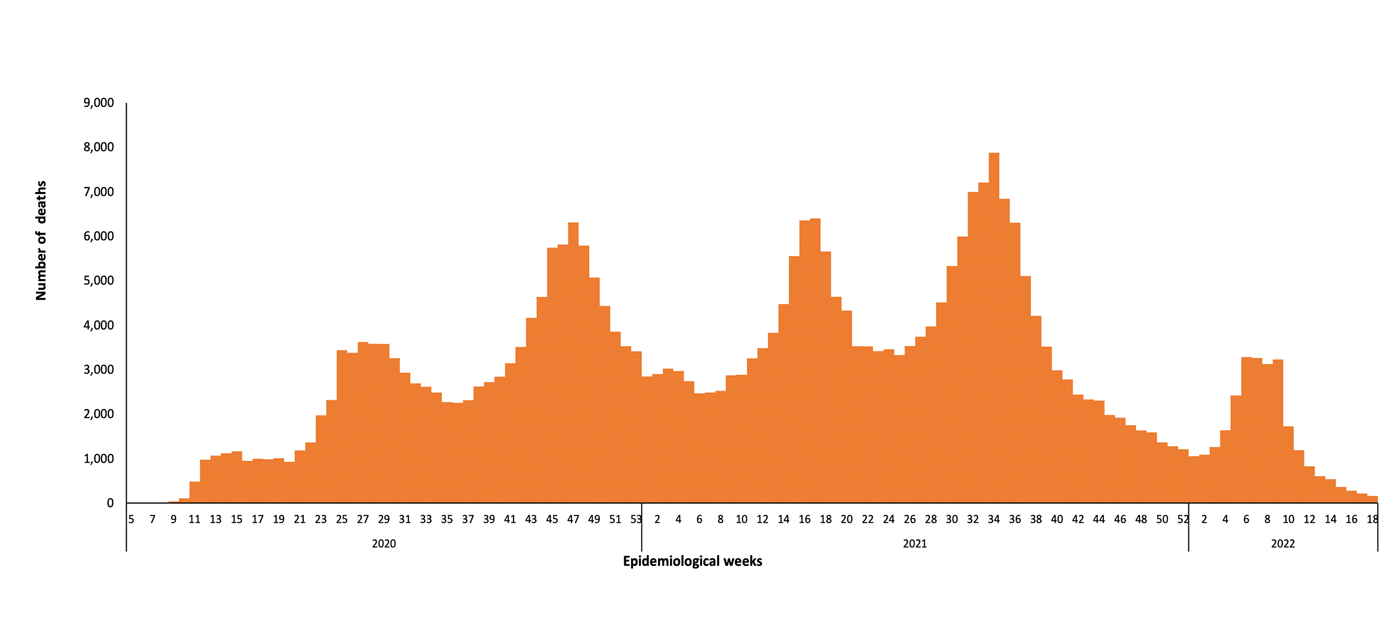The coronavirus disease COVID-19 continues to spread at the regional and global levels. As of 7 May 2022, the global cumulative incidence reached 515 092 445 reported cases and 6 270 219 associated deaths at a case-fatality ratio (CFR) of 1.22%. Meanwhile, the 22 countries of the Eastern Mediterranean Region (EMR) have reported a total of 21 716 236 cases, representing about 4.22% of the global count, with 342 823 associated deaths (CFR 1.58%). Most countries in the Region are in the community transmission phase.
Since the beginning of the outbreak, the country that has reported the highest number of total cases in the Region is Islamic Republic of Iran (7 224 701 cases; 33.27% of the Region’s total), followed by Iraq (2 325 522; 10.71%) and Jordan (1 696 054; 7.81%). Islamic Republic of Iran also reported the highest number of total COVID-19 associated deaths (141 165; CFR 1.95 %) followed by Pakistan (30 375; CFR 1.99 %) and Tunisia (28 575; CFR 2.74 %). The highest CFRs were reported by Yemen (18.18%) followed by Sudan (7.94%) and Syria (5.64%), while the lowest CFRs were reported by Qatar (0.19%), United Arab Emirates and Bahrain (0.26% for both).
During epidemiological week 18, the Region reported a decrease in cases by 19% when compared to the previous week (12 650 cases compared to 15 616 cases). A decrease by 27.0 % was also observed for associated deaths (157 deaths in the current week compared to 214 deaths in the last week).
The weekly number of cases have decreased in all countries of the Region except in Bahrain (increased from 2 876 to 3 376), occupied Palestinian territory (increased from 0 to 133), Oman (increased from 90 to 147), Pakistan (increased from 100 to 782), Saudi Arabia (increased from 679 to 1 065), Sudan (increased from 20 to 26) and Syria (increased from 21 to 31) as compared to the previous week. In the current week the number of COVID-19-associated deaths also decreased in all countries of the region except in Bahrain (increased from 0 to 2), Pakistan (increased from 0 to 6), and Sudan (increased from 2 to 3) as compared to the previous week.*
In terms of testing, a total of 385 888 516 laboratory tests were conducted since the start of the outbreak across the Region including 1 892 792 tests in week 18, which shows a 27% decrease compared to the previous week when 2 603 492 tests were conducted. The highest number of PCR tests were reported from United Arab Emirates (157 058 072), followed by Islamic Republic of Iran (51 446 960) and Saudi Arabia (41 966 629). The average positivity rate for the Region is 5.63%. WHO recommends a positivity rate of around 3 to 12.% as a general benchmark indicating adequate testing, which was achieved in most countries of the Region.
Meanwhile, COVID-19 vaccination continues across the Region. The total number of doses administered so far in the 22 countries is 726 300 731. Pakistan has administered the highest number of doses 252 931 485, followed by Islamic Republic of Iran at 148 340 509 and Egypt at 82 017 392. On the other hand, Somalia (2 651 515), Yemen (821 853), Djibouti (179 909), and Oman (64 861) administrated the lowest number of COVID-19 doses in the Region.**
Supporting countries in the Region
The regional incident management support team continues to coordinate the response and provide technical support to countries and partners in the Region in the areas of coordination and partnership, surveillance, laboratory capacity, clinical management, infection prevention and control, risk communication and community engagement, points of entry according to the International Health Regulations (2005), research, health systems, and essential health services among others.

 For more data from the Region, please visit the COVID-19 dashboard.
For more data from the Region, please visit the COVID-19 dashboard.
*Reporting on weekly relative difference instead of cumulative difference to better reflect the extent of the COVID-19 pandemic as we witness a decline in reported cases. This decline could be partially due to the change in the frequency and quality of data being shared by some countries as they moved to reporting through weekly aggregated data.
**The data on vaccination is obtained from a number of sources including media reports and country websites for ministries of health.
Subscribe to the monthly infectious hazard preparedness newsletter of WHO’s Health Emergencies Programme for the latest data and analysis on the epidemic- and pandemic-prone diseases, as well as news on outbreak preparedness and response within WHO’s Eastern Mediterranean Region.




